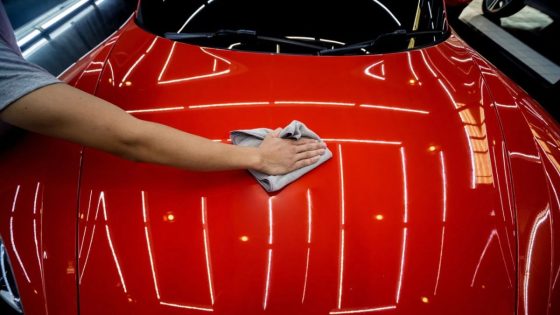PPF vs. Ceramic Coating: Which Protects Your Car Best?،
Navigating the automotive landscape hasn't always been easy, especially when it comes to combating wear and tear on vehicle body coverings. The recurring problem of paint damage leading to the slow erosion of vehicles by rust persists over the years.
During the Vietnam War, the U.S. Army faced a unique challenge: scratches and paint damage on its vehicles. Surprisingly, this drawback carries over to our current experiences. Seeking a solution to the ongoing problem of vehicles succumbing to debris and the harsh impacts of natural elements, the U.S. Army turned to its local retailers for help.
Over time, the automotive world has turned its attention to the emergence of ceramic coating products. In 2000, these coatings debuted as a way to protect vehicle exteriors. As the century progressed, ceramic coatings became a common solution in the industry, gaining popularity among car owners. Currently, they are recognized as essential products to ensure the longevity of automobiles, ready to last for generations. Find a complete comparison between PPF and ceramic coating below.
What is PPF?
Paint protection film, often referred to as PPF and Clear Bra, has become a common term in the automotive industry. Although the term Clear Bra may sound funny, it is a product and term used in the past. Examining images of cars from the 1990s reveals a precursor to PPF: a black leather covering attached to the front, aptly named Black Leather Bra. It was essentially a thicker version of today's paint protection film, demonstrating the evolution of this protection technology.
Technological advancements have transformed paint protection film (PPF) into a transparent, flexible material that fits seamlessly into vehicle crevices. PPF outperforms ceramic coatings, providing hydrophobic properties that repel water and robust protection against contaminants, acid rain, insect splatters and rock chips. Its elastomeric polymer top layer absorbs damage and returns to its original shape, making PPF a superior choice for vehicle protection.
What is ceramic coating?
Ceramic coating provides a semi-permanent protective layer for your vehicle, applicable to paint, chrome and plastic trim. Its key ingredients, silica dioxide and titanium dioxide, provide robust defense for the car's exterior. The coating is applied, filling the microscopic pores in the paint and imparting a glossy finish. Thanks to its hydrophobic properties, the paint exhibits water-repellent characteristics, ensuring a consistently clean appearance.
PPF or ceramic coating
| Appearance | Paint Protection Film (PPF) | Ceramic coating |
| Application | Applied as a film, providing full coverage | Applied in liquid form, binding to the surface to form a protective layer |
| Composition | Transparent and flexible material | Semi-permanent layer with silica dioxide and titanium dioxide |
| Visibility | Virtually invisible when applied correctly | Gives a glossy finish to the painted surface |
| protection | Excellent defense against contaminants, rock chips and more | Robust protection against various elements and chemicals |
| Flexibility | Malleable and can be stretched to fit complex spaces | Forms a durable layer on the surface |
| Hydrophobic properties | Demonstrates water beading characteristics, keeping the car clean | Provides hydrophobic properties, promoting water beading |
| Repairability | Can be replaced if damaged or worn | Repairs may require reapplication of coating |
| Sustainability | Durable, with an elastomeric polymer top layer that absorbs and rebounds when damaged | Semi-permanent, requiring reapplication every few years |
| Appearance | Maintains a clear, invisible appearance when properly installed | Improves shine and appearance, showcasing a sleek finish |
PPF or ceramic coating; Which should you choose?
Although PPF and ceramic coatings offer many benefits, their distinctive characteristics make them suitable for different aspects of vehicle protection.
Benefits of PPF:
1. Superior protection against road debris and rock chips.
2. Absorbs damage before it hits the paint.
3. Maintains a glossy finish.
4. Offers a protective urethane film.
PPF Considerations:
1. This is not a permanent solution; it may need to be replaced as the film ages.
2. Possibility of discoloration (yellowing) and blistering over time.
3. Can potentially dull the gloss of paint.
Advantages of ceramic coating:
1. Provides a glossy finish, improving the appearance of the vehicle.
2. Acts as a permanent solution.
3. Excellent protection against various elements.
Ceramic Coating Considerations:
1. Limited protection against road debris and rock chips compared to PPF.
2. Does not have urethane film to absorb shock.
3. Requires reapplication every few years for optimal performance.
The choice between PPF and ceramic coating depends on your specific priorities. If superior rock chip protection is crucial, PPF may be preferred. For those looking for a more permanent solution with an improved shine, ceramic coating could be the ideal choice.
Our thoughts on PPF and ceramic coating
It’s about what matters most to the buyer. PPF shines in its ability to protect against rock chips and scratches, providing robust defense to the paintwork. On the other hand, the ceramic coating provides that glossy finish and makes the car easier to clean thanks to its hydrophobic nature. Both are excellent choices, and the decision ultimately comes down to convenience and features that match the buyer's priorities. It's all about finding the perfect place that fits your preferences and fits seamlessly into your car care routine.
You can follow Smartprix on Twitter, Facebook, Instagram and Google News. Visit smartprix.com for the latest news, reviews and technical guides.
















